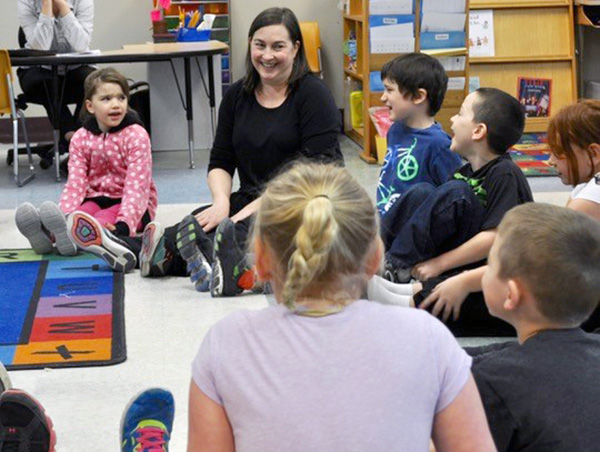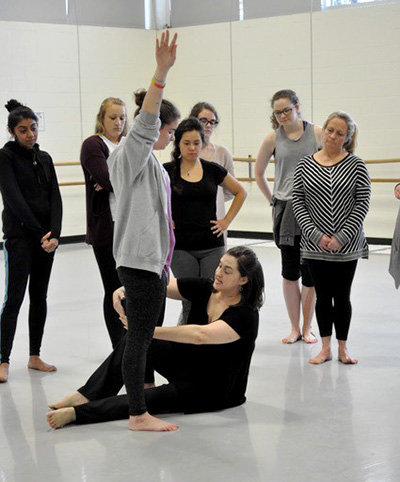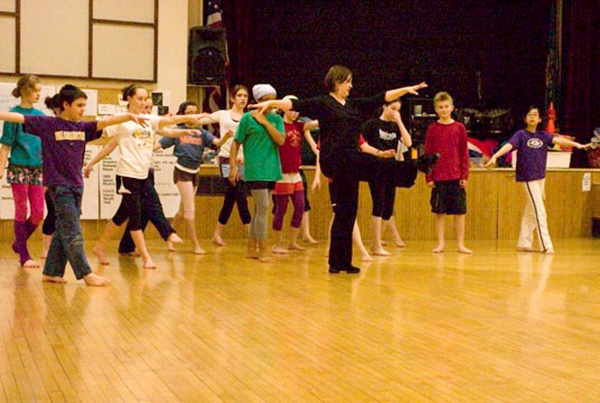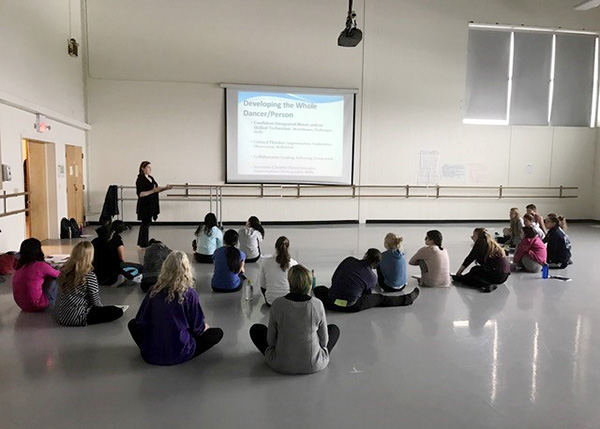Rethinking Dance Education
An Interview with Terry Goetz
BY EMMALY WIEDERHOLT
Terry Goetz is the director of the Creative Dance Center in Seattle. She took over from Anne Green Gilbert, who developed BrainDance and a brain-based approach to dance education. Terry shares how she came to value and support this approach, as well as how revolutionary yet essential it is.
~~
How did you come to be passionate about dance education?
Like most retiring dancers, teaching seemed like an obvious transition. I started teaching while pregnant with my first daughter, just teaching ballet classes to adults and kids, and really loved it. When my daughter was toddler age, I wondered if there was a dance class we could take together. At that point, I had started teaching creative dance classes in addition to ballet, but didn’t really know what I was doing. The studio had a basic curriculum that was handed down to me and was geared toward ballet – dancing with scarves, flexing and pointing feet, stretching, leaping over cones from the corner. I found this not so satisfying and knew innately it wasn’t the best thing for the kids developmentally, and as a result was dealing with behavior issues.
I found the Creative Dance Center in the Yellow Pages. Anne Green Gilbert taught the Wednesday night toddler class, and I went with my daughter. The first class was completely different than any other class I’d ever taken. Even the way the studio was decorated was different; there were posters listing dance concepts and showing locomotor and non-locomotor skills, and there were multisensory props. Beyond that, the lesson plan was so clear and purposeful. I was trained in traditional ballet, and the concepts Anne presented were foreign to me. Midway through the first session, I told her I used to dance professionally and was teaching now, and had some management issues with my preschool classes. I asked her for advice, how the kids were waiting in the corner to go across the floor, and they weren’t paying attention or prepared for their turn, and she asked me why they were waiting in the corner to go one at a time in the first place. Why not all dance together in scattered formations? It was such a simple suggestion but mind-blowing to someone who had spent years waiting in the corner to take a turn across the floor! And it transformed my classes!
From there, Anne suggested I attend the Summer Dance Institute for Teachers she holds every year. This was in 1997. I came home every night exploding with information. I made a vow that I would format my creative dance classes differently. It took practice to think differently about movement. I went back to the Summer Dance Institute multiple times, and the more I immersed myself in Anne’s work, the less satisfying teaching straight technique classes became. I was teaching ballet in a conservatory setting, and started introducing Anne’s dance concepts and improvisation, but it wasn’t a fit for that environment even though the students clearly loved it. Anne had asked if I would teach some classes at the Creative Dance Center and, after teaching and using her methods for a few years at other studios and preschools, I felt ready to join the faculty at CDC. This was in 2000.
How is the Creative Dance Center approach different than more traditional dance schools?
When I attend conferences with the National Dance Education Organization or I read the Journal of Dance Education, I feel there’s a shift happening in dance education. There is a focus on the introduction of somatic practices, more inquiry based learning, and giving students the tools to be creative and expressive artists, not only technically proficient dancers. This is happening in some studios as well, though I’m not sure if it is filtering as strongly into studios that are primarily competition based. There’s an increasing sense that we should be teaching the whole person, not just teaching steps. It can be focusing on breath, or bringing in Alexander Technique, Feldenkrais, Bartenieff, Laban, experiential anatomy, or yoga into technique classes, or encouraging creativity and social-emotional connections and learning.
But, at the same time, when I take classes myself, I don’t often experience that much of a shift. I recently attended a conference and took classes with teachers from all over the world. They were lovely people who created a warm environment, but the most community-based thing we did was gather in a circle at the beginning of class. From there, it went to a traditional class format with the teacher in front facing the mirror, and students learning combinations and then practicing in groups. The teacher would say, “Smile, have fun!” And I’d have that old worry and anxiety about not getting the combo, being watched and judged. That might be my own thing, but I know those are feelings everyone has experienced. It surprises me still that this is the dominant format: Copy me, do it in split groups. There’s no reflection or emotional engagement with peers, no creative component to play with and explore class content. Even though there’s this shift or a changing awareness of what dance education can and should be, in many classes I still experience this traditional approach to teaching. Teachers tell students to “dance it” but actually haven’t given any concrete tools that can lead to more expressivity. This is not to say there aren’t many teachers who are teaching the whole person and thinking about pedagogy in a more holistic sense (for example, Bill Evans, an important mentor to me, has developed a pedagogy that honors personal uniqueness, teaches concepts, cultivates community, embraces change, and integrates improvisation and reflection into technique class) but I often find myself a bit shocked and surprised that Anne’s work is as radical as it is.
With Anne’s methodology, she combines the mastery of movement skills or technique with the expressivity of creative dance. These are often seen as opposites. Creative dance is seen as free authentic movement, while traditional dance training is skills or technique based. Anne sees value in both, that it’s important to develop a technical toolbox alongside a creative voice. And she developed a five-part lesson plan that gives students tools they can use to develop as dancers, artists and people.
How would you describe the BrainDance to someone unfamiliar with it?
People get confused between the BrainDance and what Anne calls Brain-Compatible or Brain-Based Dance Education. The overarching umbrella of Anne’s methodology is Brain-Compatible Dance Education. Anne researched somatics, neuroscience and the biology of learning, and noticed there are certain principles like needing to feel safe and happy in order to learn, needing to engage with other humans, the need for both novelty and repetition, the need to reflect on and process our experiences, and the importance of a multisensory environment that keep coming up across fields. Brain-Compatible Dance Education is a methodology for most effectively introducing material based on how humans learn best. The other key component of her methodology is that it is conceptually based. Anne simplified the language of Laban and developed a conceptual vocabulary that includes space, time, force and body, and in a five-part lesson one or two of these dance concepts are chosen to be the focus for each part of the lesson.
Within that methodology, Anne developed the BrainDance. It’s essentially a warmup, but it can be used on its own as well. At the Creative Dance Center, the BrainDance is the first part of the five-part lesson plan that comprises every class. It’s a set of eight movement patterns that build off of Bartenieff Fundamentals, Bonnie Bainbridge Cohen’s work, reflexes and developmental movement. The BrainDance includes breath, tactile, core-distal movement, head-tail spinal movement, upper and lower body movement, body halves/sides, cross lateral movement, and vestibular movement. Eye-tracking (horizontal, vertical, near/far) is also included in the BrainDance.
I think of the BrainDance as a profound and flexible movement tool that is sequential and holistic. It goes from the most basic movement necessary for life – breath – to complex cross lateral movement patterns and movements that challenge our balance system. The final three patterns – upper-lower, body sides, and cross lateral – are basically the patterns that support dance technique across many genres. Over the past 18 years that I’ve been involved with Anne’s work, I’ve had some big AHA moments, but when I realized that a ballet technique class and the movements we do at barre and in center are basically built on developmental movement/progression and are a fancy version of a BrainDance, that was when I began to really integrate and use the BrainDance patterns as tools for teaching and clarifying technique with my students.
How do you teach ballet now?
I use Anne’s five-part lesson plan, and it always starts with a BrainDance that is infused with the dance concept. Moving through the patterns warms up my students in a very holistic way. They connect to their breathing, they receive valuable sensory information as they move through the tactile pattern, they shrink and grow from core to distal discovering their kinesphere and activating core support, they play with rotation, flexion, and extension in the head-tail pattern, explore gradated rotation of their proximal joints in the upper-lower, body-side, and cross lateral patterns (as well as grounding, stability/mobility, and full three dimensional movement!), they challenge their balance system and strengthen it through vestibular movement, and they are increasing their heart rate… so by the time they come to barre they are warm, integrated, and have an enormous amount of information they can pull from as they work at barre.
The second part of the lesson plan is exploring the dance concept. The dance concept for the class will carry throughout the entire lesson. We explore the dance concept through improvisation and in ballet. I like to make sure that my students have the chance to improvise alone, but also with partners or in small groups. I want them to engage with each other, problem solve, reflect and share. This is very different than the ballet classes I had growing up!
The third part of the lesson plan is developing skills and this is where barre and center work is done. I may tweak the structure of Anne’s lesson plan a bit for my ballet classes depending on the content I want to teach. Often after the BrainDance, we go straight to barre and I will have them explore the dance concept as a way to recuperate and get into their expressive selves in between combinations at the barre, for example 16 counts dancing in curvy pathways through general space and 16 counts dancing in zig zag pathways back to the barre. After barre I may have them do a quick partner improv, reflect and share, and then move on to center work.
The fourth part is creating (this can be a structured improvisation or a task or choreographic prompt given to the dancers to create their own dances), and the fifth part is cooling down (this can be sharing the dances created and giving feedback or having the dancers lead each other in a mirroring cool-down that has the lesson’s dance concept as the focus). The concept should weave through all the lesson, even the technique. If the concept is energy, for example, we might focus on the smooth and sharp moments in a combination.
The beauty of teaching this way is that it allows every student to experience the full spectrum of movement qualities. Students practice being strong, but also being light, or being slow/fast, or sharp/smooth, etc. Everyone has patterned ways of being in their bodies, and for someone who has never felt strong and shared weight, it can be incredibly empowering, as well as risky, to feel that. Success to me is watching students take those risks. For other students who might be strong or heavy in the way they move through life but not have the ability to modulate to being light, discovering lightness can also be empowering. We start to feel that range in ourselves, as well as acknowledge, notice and appreciate the range in others. That’s part of the reflection built into the classes.
This is a lot to integrate into one class, and it takes practice. However, I can adapt this basic structure to any length of class on any age group. This is one reason why Anne’s work is so accessible and practical. It can work if you are a teaching artist going in to a public school and have 30 minutes to teach, it can work if you are teaching senior citizens in an assisted living facility, and it can work in a private studio. At the Creative Dance Center, the shortest class is 60 minutes. For the older students, classes are 75 minutes, 90 minutes, or up to two hours for our modern classes. Modern classes start with a long BrainDance, then exploring the dance concept through improvisation. We usually do floor work infused with Bartenieff Fundamentals. Then often another improv working with partners, trios or quartets. From there we do standing technique and center work. At the end of class the students collaborate and generate choreography and composition, sometimes they might create solos. We share, reflect and process, which builds dance vocabulary. The students are asked to use conceptual language to describe what they see and become pretty sophisticated in dance literacy from a young age!
For students who want to pursue dance beyond the Creative Dance Center, do you feel they are well prepared for the larger dance world?
One former student, who went on to Hampshire College, recently wrote to Anne that she had no idea the way she was trained was so embodied and sophisticated until she realized that much of what she was learning in college she had experienced growing up at CDC. Dancers often write back to us and share that they’ve noticed their peers in college did not receive the same type of holistic dance education. Many of our students look for programs with a strong somatic focus and where they know their own individual voice and creativity will be nurtured. We hear back from students who have gone on to college dance programs that they are grateful they grew up with the BrainDance, improvising and exploring the dance concepts, collaborating, and creating dances with their peers. They are at an advantage to other students coming from more traditional settings who didn’t have a chance to experience dance in this way. Choreographers and directors see a deeply embodied expressive quality in our dancers. If the focus is to really develop their technique, the foundation is there.
When do you feel most successful as a dance teacher?
I feel successful when people are smiling and laughing. It’s such a difference to how I grew up and what my dance training was like. If students are smiling and laughing, I know they are learning. If I can feel and witness connection and engagement between me and my students and in the relationships my students develop with each other, I feel successful.
I also feel successful when I observe those moments of risk-taking. The BrainDance is an incredible assessment tool that can give you a lot of information about students. It can be a window into what’s going on emotionally, psychologically, and kinesthetically. If I see a student shift over the course of many classes and begin to move past inhibitions or explore movement outside of their natural movement signature, that feels very satisfying. I enjoy creating an environment of support so students feel safe to take those risks.
Any other thoughts?
I didn’t mention the inclusive aspect. There have been children with disabilities or special needs in Creative Dance Center classes since Anne founded CDC. The way that classes are structured, everyone can come into movement in their own way, any level can participate, and it pulls the teacher out of being the one with all the knowledge so we all learn with each other.
One more thing: For many years, it seemed that when the dance community looked at Anne’s work, it was seen as only creative dance. Modern dance was always a big piece of the curriculum at CDC, but I’m not sure those who were familiar with her work through her books realized the depth of how she combined technique and creative work. When I joined the faculty, with her encouragement, I started playing with how ballet could fit into the methodology. But there can still be this idea that her work is only creative dance or for younger dancers. In truth, the work can be applied to any dance genre and to any level of dancer. You could teach hip hop or tap, and increasingly there are teachers doing this. Even in some college dance programs there’s a binary between technique and improv/choreography. Anne’s lesson plan lets you put it all together in one wonderful package. From a practical perspective, if you can nurture a person from an expressive standpoint and also give them technical tools, why not do that?
~~
Terry Goetz has been on the faculty of the Creative Dance Center since 2000 and took over as director from Anne Green Gilbert in 2014. She began training intensively with Anne Green Gilbert in 1997 and has also studied with Bill Evans at his teacher intensives. Terry has taught dance in preschools, elementary classrooms and in dance studios throughout the Seattle area since retiring from Pacific Northwest Ballet. She danced with Pittsburgh Ballet Theatre from 1986-1988 and Pacific Northwest Ballet from 1988-1995. Terry presents workshops locally, nationally and internationally in BrainDance and Brain-Compatible Dance Education. She worked with the Office of the Superintendent of Public Instruction in Washington state as a dance specialist developing updated state-wide K-12 learning standards for dance. She is an active member of the National Dance Education Organization and served as president of the Dance Educators Association of Washington. Terry was named Dance Educator of the Year in Washington for 2015.
To learn more, visit www.creativedance.org.





2 Responses to “Rethinking Dance Education”
Thanks Ingrid! I’m so glad you’re spreading the work!
Thank you for featuring Terry and the work of Anne Green Gilbert and The Creative Dance Center. I, too, trained with Anne and taught alongside Terry at CDC. I currently am creating classes for young children using all this basic information and the BrainDance in Santa Fe.
Comments are closed.